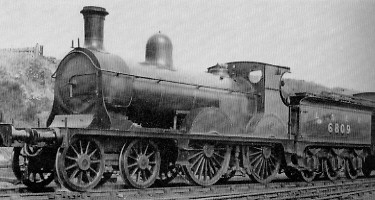The Manson D42 (GNSR Class O) 4-4-0 Locomotives

Manson introduced a number of 4-4-0 designs for the Great North of Scotland Railway (GNSR) between 1883 and 1887. However in 1887, the GNSR Directors requested larger engines to handle increasing passenger traffic loads, and Manson designed his Class O (LNER D42) locomotives to meet this need. Nine D42 locomotives were built by Kitson & Co. in 1882. These engines were similar to the earlier Class N (LNER D46) engines. The boiler diameter of 4ft 6in was retained, but the firebox was lengthened from 5ft 6in to 6ft 0in. This resulted in an increase in the coupled wheelbase from 8ft 4in to 8ft 9in. The cylinder diameter was increased from 17.5in to 18in, and the slide valves were moved from between the cylinders to above them. This new valve position required the use of rocking shafts, but had the advantage that balanced slide valves could be used. All of Manson's previous 4-4-0 designs had used unbalanced slide valves. These changes would set the standard GNSR 4-4-0 type for the remainder of its existence. Although there would be numerous small changes, boiler and cylinder sizes would remain constant.
Another new feature that was introduced on the D42s and was retained on all later GNSR 4-4-0s, was that of the bogie wheels. The original design called for the usual 3ft 0in diameter bogie wheels. However five months after the order was placed, Manson requested larger 3ft 9in bogie wheels. Kitson complied but the GNSR had to pay £25 extra per locomotive. These large 3ft 9in wheels would become a distinctive feature of the later GNSR 4-4-0 designs.
New boilers were fitted to all of the D42s between 1915 and 1920. The new boilers were of the same size, but five had superheaters fitted. No. 74 initially received a boiler fitted with a Schmidt superheater as an experiment. When the superheating experiment was deemed successful, boilers with Robinson superheaters were fitted to Nos. 17, 18, 72, & 73. The LNER regularly exchanged boilers between the D42s, D38s, and D43s; but the pattern of saturated and superheated boilers remained the same. The LNER eventually fitted a Robinson superheater to No. 6874 (GNSR No. 74), bringing it inline with the other superheated D42s.
The D42s were initially fitted with Ramsbottom safety valves with exposed columns and spring. When the new boilers were fitted from 1915, a separate casing that enclosed the columns and spring was fitted. The LNER replaced the Ramsbottom valves with Ross pop safety valves on all of the D42s during the 1920s.
The D42s were built with Roscoe and Furness lubricators. These were replaced with Detroit sight-feed lubricators by the GNSR before Grouping (1923).
The D42s were initially allocated to main line passenger duties between Aberdeen and Elgin. As later 4-4-0s (e.g..the D40s) were introduced, they were displaced to secondary duties. By Grouping (1923), they could be found across the GNSR system. Typical allocations and duties during the 1920s included Elgin (the Lossiemouth branch), Boat of Garten (Speyside line), and Kittybrewster and sub-sheds. The Kittybrewster engines worked a number of main line services to Keith and Elgin, as well as the Buchan section to Peterhead and Fraserburgh, and Deeside. In common with most GNSR 4-4-0s, the D42s spent most of their lives operating a wide range of duties including passenger services, freight, branch lines, and even shunting.
Withdrawals started with No. 6804 in 1935. Two remained in service at the outbreak of World War 2 (1939), when withdrawals paused. The last two D42s were withdrawn in April 1945 (No. 6807) and February 1946 (No. 6817).
Technical Details
| Saturated | Superheated | ||
| Cylinders (x2): | (inside) | 18x26in. | 18x26in. |
| Motion: | Stephenson | Stephenson | |
| Valves: | slide | slide | |
| Boiler: | Max. Diameter: | 4ft 6in | 4ft 6in |
| Boiler: | Pressure: | 165psi | 160psi |
| Diagram No.: | 88 | 88 | |
| Heating Surface: | Total: | 1165 sq.ft. | 1000 sq.ft. |
| Firebox: | 106 sq.ft. | 106 sq.ft. | |
| Superheater: | 140 sq.ft. (18x1.1in) | ||
| Tubes: | 1059 sq.ft. (213x 1.75in) | 512 sq.ft. (104x 1.75in) | |
| Flues: | 242 sq.ft. (18x 4.75in) | ||
| Grate Area: | 18.2 sq.ft. | 18.2 sq.ft. | |
| Wheels: | Leading: | 3ft 9.5in | 3ft 9.5in |
| Coupled: | 6ft 0.5in | 6ft 0.5in | |
| Tender: | 3ft 9.5in | 3ft 9.5in | |
| Tractive Effort: | (@ 85% boiler pressure) | 16,296 lb | 15,802 lb |
| Wheelbase: | Total: | 40ft 10in | 40ft 10in |
| Engine: | 21ft 8in | 21ft 8in | |
| Tender: | 11ft 0in | 11ft 0in | |
| Weight (full): | Total: | 73 tons 0cwt | 75 tons 7cwt |
| Engine: | 44 tons 0cwt | 46 tons 7cwt | |
| Tender: | 29 tons 0cwt | 29 tons 0cwt | |
| Adhesive Weight: | 29 tons 16cwt | 31 tons 1cwt | |
| Max. Axle Load: | 15 tons 3cwt | 15 tons 18cwt |
Preservation
The last D42 was withdrawn in 1946, and none have survived into preservation.
Models
I am not aware of any models of the D42 in any scale.